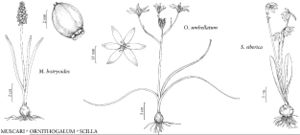Difference between revisions of "Muscari botryoides"
Gard. Dict. ed. 8, Muscari no. 1. 1768.
FNA>Volume Importer |
imported>Volume Importer |
||
| (6 intermediate revisions by 2 users not shown) | |||
| Line 8: | Line 8: | ||
}} | }} | ||
|common_names=Common grape-hyacinth;muscari | |common_names=Common grape-hyacinth;muscari | ||
| − | |basionyms={{Treatment/ID/ | + | |special_status={{Treatment/ID/Special_status |
| + | |code=W2 | ||
| + | |label= | ||
| + | }}{{Treatment/ID/Special_status | ||
| + | |code=I | ||
| + | |label=Introduced | ||
| + | }}{{Treatment/ID/Special_status | ||
| + | |code=F | ||
| + | |label=Illustrated | ||
| + | }} | ||
| + | |basionyms={{Treatment/ID/Basionym | ||
|name=Hyacinthus botryoides | |name=Hyacinthus botryoides | ||
|authority=Linnaeus | |authority=Linnaeus | ||
| + | |rank=species | ||
| + | |publication_title=Sp. Pl. | ||
| + | |publication_place=1: 318. 1753 | ||
}} | }} | ||
|synonyms= | |synonyms= | ||
| Line 27: | Line 40: | ||
|elevation=0–1500 m | |elevation=0–1500 m | ||
|distribution=B.C.;Nfld. and Labr. (Nfld.);N.S.;Ont.;Ala.;Ark.;Calif.;Conn.;Del.;D.C.;Ill.;Ind.;Kans.;Ky.;Md.;Mass.;Mich.;Minn.;Miss.;Mo.;N.H.;N.J.;N.Y.;Ohio;Okla.;Oreg.;Pa.;Tenn.;Tex.;Utah;Vt.;Va.;Wash.;W.Va.;c;se Europe;expected elsewhere. | |distribution=B.C.;Nfld. and Labr. (Nfld.);N.S.;Ont.;Ala.;Ark.;Calif.;Conn.;Del.;D.C.;Ill.;Ind.;Kans.;Ky.;Md.;Mass.;Mich.;Minn.;Miss.;Mo.;N.H.;N.J.;N.Y.;Ohio;Okla.;Oreg.;Pa.;Tenn.;Tex.;Utah;Vt.;Va.;Wash.;W.Va.;c;se Europe;expected elsewhere. | ||
| − | |discussion=<p>Muscari botryoides is the commonest and most cold-hardy of the Muscari species in the flora.</p> | + | |introduced=true |
| + | |discussion=<p><i>Muscari botryoides</i> is the commonest and most cold-hardy of the <i>Muscari</i> species in the flora.</p> | ||
|tables= | |tables= | ||
|references= | |references= | ||
| Line 36: | Line 50: | ||
-->{{#Taxon: | -->{{#Taxon: | ||
name=Muscari botryoides | name=Muscari botryoides | ||
| − | |||
|authority=(Linnaeus) Miller | |authority=(Linnaeus) Miller | ||
|rank=species | |rank=species | ||
| Line 51: | Line 64: | ||
|publication title=Gard. Dict. ed. | |publication title=Gard. Dict. ed. | ||
|publication year=1768 | |publication year=1768 | ||
| − | |special status= | + | |special status=W2;Introduced;Illustrated |
| − | |source xml=https:// | + | |source xml=https://bitbucket.org/aafc-mbb/fna-data-curation/src/2e0870ddd59836b60bcf96646a41e87ea5a5943a/coarse_grained_fna_xml/V26/V26_634.xml |
|genus=Muscari | |genus=Muscari | ||
|species=Muscari botryoides | |species=Muscari botryoides | ||
Latest revision as of 21:16, 5 November 2020
Plants to 20(–30) cm. Bulbs ovoid, 1.5–2.5 × 1–2 cm, offsets absent, tunics translucent to pale brown. Leaves 2–4(–5); blade prominently ribbed, linear-spatulate, 15–35(–40) cm × 3–8(–12) mm, apex abruptly contracted. Scape 20–35(–40) cm, usually slightly exceeding leaves. Racemes 12–20-flowered. Flowers: perianth tube sky blue, globose to ovoid, 2–4 × 2–3 mm, teeth white; fertile and sterile flowers ± equal (sterile may be slightly smaller and paler); pedicel spreading, 1–3(–5) mm. Capsules 4–6 × 4–6 mm. 2n = 18, 36.
Phenology: Flowering early–mid spring.
Habitat: Roadsides, fields, woods, abandoned gardens
Elevation: 0–1500 m
Distribution
Introduced; B.C., Nfld. and Labr. (Nfld.), N.S., Ont., Ala., Ark., Calif., Conn., Del., D.C., Ill., Ind., Kans., Ky., Md., Mass., Mich., Minn., Miss., Mo., N.H., N.J., N.Y., Ohio, Okla., Oreg., Pa., Tenn., Tex., Utah, Vt., Va., Wash., W.Va., c, se Europe, expected elsewhere.
Discussion
Muscari botryoides is the commonest and most cold-hardy of the Muscari species in the flora.
Selected References
None.
